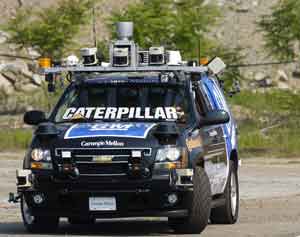A self-driving SUV developed by Carnegie Mellon University's Tartan Racing has won the $2m first prize in the Defense Advanced Research Projects Agency's (DARPA) Urban Challenge.
The event, which was held last Saturday, pitted eleven autonomous vehicles against each other on a course of suburban and urban roadways.
After reviewing judges' scorecards overnight, DARPA officials concluded that Boss, a robotised 2007 Chevy Tahoe, followed California driving laws as it navigated the course and that it operated in a safe and stable manner.
One of the team's advantages was a software system it developed called TROCS, which produced graphic animations of Boss's sensor and data inputs during each run. TROCS enabled Tartan Racing to understand what Boss saw as it drove and how and why it responded to its environment. Troublesome behaviours could be quickly identified and fixed, while appropriate behaviours, which might occasionally look odd to an observer, were left untouched.
Surprisingly, many of the robots made good decisions, said DARPA Director Tony Tether. That meant speed became the determining factor, Tether said, and Boss was the fastest of the competitors by a large margin. Boss averaged about 14 miles an hour over approximately 55 miles, finishing the course about 20 minutes ahead of the second-place finisher, Stanford University.
As the second-place finisher, Stanford received $1m. Virginia Tech's Victor Tango team finished third and received $500,000. The robots entered by teams from the University of Pennsylvania, Cornell and MIT also finished the race, though Cornell and MIT both exceeded the six-hour time limit set by DARPA.

Tartan Racing includes Carnegie Mellon faculty, staff and students from the School of Computer Science's Robotics Institute, as well as Carnegie Mellon's College of Engineering.
It received major support from General Motors, Caterpillar and Continental. Strengthening the team were engineers from GM, Caterpillar, Continental and Intel.




Red Bull makes hydrogen fuel cell play with AVL
Formula 1 is an anachronistic anomaly where its only cutting edge is in engine development. The rules prohibit any real innovation and there would be...